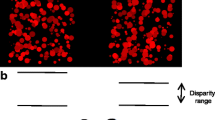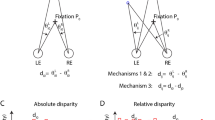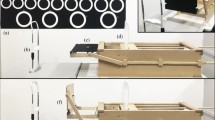Abstract
This study investigated whether the individual difference in the observer’s interpupillary distance (IPD) could cause the individual difference in perceived depth in binocular stereopsis. The horizontal retinal disparity (HRD) is one of the most potent depth cues, but the visual system could not uniquely estimate the metric depth from HRD alone. This is because the size of HRD is determined as a function not only of the size of external depth but also of the viewing distance and IPD. Thus to perceive depth veridically from HRD, observers need to adjust the scaling gain (i.e. the magnification factor when converting HRD to perceived depth), taking their IPD into account. To investigate whether the visual system performs such gain calibration, we examined the relationship between IPD size and perceived depth when observing stereograms (i.e. the visual stimulus of fixed HRD) at a fixed viewing distance with 54 observers. The results showed a significant correlation between perceived depth and IPD. This is consistent with the prediction based on the geometric relationship between depth, HRD, IPD, and viewing distance, suggesting that the visual system does calibrate the scaling gain based on the observer’s IPD. However, the measured results did not fully agree with the predictions from the geometry. The results were discussed, focusing on the errors in the estimation of scaling distance.





Similar content being viewed by others
Data availability
The datasets are available from the author upon reasonable request.
References
Howard, I.P., Rogers, B.J.: Seeing in depth: depth perception, vol. 2. University of Toronto Press, Toronto (2002)
Wheatstone, C.: XVIII. Contributions to the physiology of vision—Part the first. On some remarkable, and hitherto unobserved, phenomena of binocular vision. Philos. Trans. R. Soc. Lond. 128, 371–394 (1838)
Ono, H., Comerford, T.: Stereoscopic depth constancy in visual perception: mechanisms and processes. In: Epstein, W. (ed.) Stability and constancy in visual perception. Wiley, Ney York (1977)
Wallach, H., Zuckerman, C.: The constancy of stereoscopic depth. Am. J. Psychol. 76, 404–412 (1963)
Bradshaw, M.F., Glennerster, A., Rogers, B.J.: The effect of display size on disparity scaling from differential perspective and vergence cues. Vis. Res. 36, 1255–1264 (1996)
Brenner, E., van Damme, W.J.: Perceived distance, shape and size. Vis. Res. 39, 975–986 (1999)
Collett, T.S., Schwarz, U., Sobel, E.C.: The interaction of oculomotor cues and stimulus size in stereoscopic depth constancy. Perception 20, 733–754 (1991)
Foley, J.: Binocular distance perception. Psychol. Rev. 87, 411–434 (1980)
Glennerster, A., Rogers, B.J., Bradshaw, M.F.: Cues to viewing distance for stereoscopic depth constancy. Perception 27, 1357–1365 (1998)
Mayhew, J.E., Longuet-Higgins, H.C.: A computational model of binocular depth perception. Nature 297, 376–378 (1982)
Rogers, B.J., Bradshaw, M.F.: Vertical disparities, differential perspective and binocular stereopsis. Nature 361, 253–255 (1993)
Cumming, B.G., Johnston, E.B., Parker, A.J.: Vertical disparities and perception of three-dimensional shape. Nature 349, 411–413 (1991)
O’leary, A., Wallach, H.: Familiar size and linear perspective as distance cues in stereoscopic depth constancy. Percept. Psychophys. 27, 131–135 (1980)
Predebon, J.: The familiar-size cue to distance and stereoscopic depth perception. Perception 22, 985–995 (1993)
Watt, S.J., Akeley, K., Ernst, M.O., Banks, M.S.: Focus cues affect perceived depth. J. Vis. (2005). https://doi.org/10.1167/5.10.7
Glennerster, A., Rogers, B.J., Bradshaw, M.F.: Stereoscopic depth constancy depends on the subject’s task. Vis. Res. 36, 3441–3456 (1996)
Johnston, E.B.: Systematic distortions of shape from stereopsis. Vis. Res. 31, 1351–1360 (1991)
Johnston, E.B., Cumming, B.G., Parker, A.J.: Integration of depth modules: stereopsis and texture. Vis. Res. 33, 813–826 (1993)
Dodgson, N.A.: Variation and extrema of human interpupillary distance. Proc. SPIE Int. Soc. Opt. Eng. 5291, 36–46 (2004)
MacLachlan, C., Howland, H.C.: Normal values and standard deviations for pupil diameter and interpupillary distance in subjects aged 1 month to 19 years. Ophthalmic Physiol. Opt. 22, 175–182 (2002)
Moravej, R., Sahihalnasab, S.S.: Evaluating the pupillary distance in an Iranian population and its relation with age, sex and refractive errors. J. Ophthalmic Optometr. Sci. 1, 17–22 (2017)
Bosten, J.M., Goodbourn, P.T., Lawrance-Owen, A.J., Bargary, G., Hogg, R.E., Mollon, J.D.: A population study of binocular function. Vis. Res. 110, 34–50 (2015)
Eom, Y., Song, J.S., Ahn, S.E., Kang, S.Y., Suh, Y.W., Oh, J., Kim, H.M.: Effects of interpupillary distance on stereoacuity: the Frisby Davis distance stereotest versus a 3-dimensional distance stereotest. Jpn. J. Ophthalmol. 57, 486–492 (2013)
Shafiee, D., Jafari, A.R., Shafiee, A.A.: Correlation between interpupillary distance and stereo acuity. Bull. Environ. Pharmacol. Life Sci. 3, 26–33 (2014)
Guan, P., Banks, M.S.: Stereoscopic depth constancy. Philos. Trans. R. Soc. Lond. B Biol. Sci. (2016). https://doi.org/10.1098/rstb.2015.0253
Hibbard, P.B., Bradshaw, M.F., Langley, K., Rogers, B.J.: The stereoscopic anisotropy: individual differences and underlying mechanisms. J. Exp. Psychol. Hum. Percept. Perform. 28, 469–476 (2002)
Rogers, B.J., Bradshaw, M.F.: Disparity scaling and the perception of frontoparallel surfaces. Perception 24, 155–179 (1995)
Kaneko, H.: Does the human visual system know the geometry of space? J. Inst. Image Inform. Telev. Eng. 60, 1239–1243 (2006). ((in Japanese))
Hoffman, D.M., Girshick, A.R., Akeley, K., Banks, M.S.: Vergence-accommodation conflicts hinder visual performance and cause visual fatigue. J. Vis. (2008). https://doi.org/10.1167/8.3.33
Sato, M., Miki, A., Tamada, Y., Kaneko, H.: Modified hexagon dot stereo test: precision and accuracy of stereopsis. Jpn. J. Vis. Sci. 38, 122–127 (2017). ((in Japanese))
Adams, W.J., Graf, E.W., Ernst, M.O.: Experience can change the ‘light-from-above’ prior. Nat. Neurosci. 7, 1057–1058 (2004)
Ernst, M.O., Banks, M.S., Bülthoff, H.H.: Touch can change visual slant perception. Nat. Neurosci. 3, 69–73 (2000)
Knill, D.C.: Learning Bayesian priors for depth perception. J. Vis. (2007). https://doi.org/10.1167/7.8.13
Epstein, W.: Modification of the disparity-depth relationship as a result of exposure to conflicting cues. Am. J. Psychol. 81, 189–197 (1968)
Epstein, W., Morgan, C.L.: Adaptation to uniocular image magnification: modification of the disparity-depth relationship. Am. J. Psychol. 83, 322–329 (1970)
Taya, S., Sato, M.: Orientation-specific learning of the prior assumption for 3D slant perception. Sci. Rep. (2018). https://doi.org/10.1038/s41598-018-29361-2
Wallach, H., Moore, M.E., Davidson, L.: Modification of stereoscopic depth-perception. Am. J. Psychol. 76, 191–204 (1963)
Seydell, A., Knill, D.C., Trommershauser, J.: Adapting internal statistical models for interpreting visual cues to depth. J. Vis. (2010). https://doi.org/10.1167/10.4.1
Adams, W.J., Banks, M.S., van Ee, R.: Adaptation to three-dimensional distortions in human vision. Nat. Neurosci. 4, 1063–1064 (2001)
Epstein, W., Daviess, N.: Modification of depth judgment following exposures to magnification of uniocular image: are changes in perceived absolute distance and registered direction of gaze involved? Percept. Psychophys. 12, 315–317 (1972)
Epstein, W., Morgan-Paap, C.A.: The effect of level of depth processing and degree of informational discrepancy on adaptation to uniocular image magnification. J. Expl. Psychol. 102, 585–594 (1974)
Todd, J.T., Norman, J.F.: The visual perception of 3-D shape from multiple cues: are observers capable of perceiving metric structure? Percept. Psychophys. 65, 31–47 (2003)
Hess, R.F., To, L., Zhou, J., Wang, G., Cooperstock, J.: R: Stereo vision: the haves and have-nots. i-Perception 6(3), 1–5 (2015)
Acknowledgements
This study was supported by JSPS (Japan Society for the Promotion of Science) KAKENHI, Grant numbers 24830079 and 26870590.
Author information
Authors and Affiliations
Corresponding author
Ethics declarations
Conflict of interest
The author declares no competing interests.
Additional information
Publisher's Note
Springer Nature remains neutral with regard to jurisdictional claims in published maps and institutional affiliations.
Rights and permissions
Springer Nature or its licensor (e.g. a society or other partner) holds exclusive rights to this article under a publishing agreement with the author(s) or other rightsholder(s); author self-archiving of the accepted manuscript version of this article is solely governed by the terms of such publishing agreement and applicable law.
About this article
Cite this article
Taya, S. Do observers use their own interpupillary distance in disparity scaling?. Opt Rev 30, 41–49 (2023). https://doi.org/10.1007/s10043-022-00780-x
Received:
Accepted:
Published:
Issue Date:
DOI: https://doi.org/10.1007/s10043-022-00780-x




